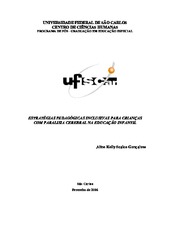Estratégias pedagógicas inclusivas para crianças com paralisia cerebral na educação infantil
Abstract
The school inclusion of students with special educational needs, understood not
only as the legal guarantee of the right of attending school but also the permanence and
success in the process of education of those students in an ordinary classroom of a
regular school, is still an aim which is very distant from the reality of our schools. The
educational systems, schools and teachers still face a lot of difficulties in providing the
necessary resources in order to guarantee a successful process of school inclusion. One
of the difficulties has been the lack of knowledge of the teachers about what they could
do to increase participation, ensure access to the curriculum (syllabus) and favor the
integration and acceptance of the students with special educational needs in the group.
The present study had as its objective to describe and analyze how the process of
inclusion of children with Brain Paralysis in Child Education, focusing specifically the
pedagogical strategies which are being used to fulfill the needs of those children as to
ensure the access and permanence as well as their participation in the activities
proposed in classroom. Three teachers of the municipal Elementary School system of
Sao Carlos and three children who have Brain Paralysis participated on this study. The
study, of qualitative nature, based on ethnographic referential, has involved an outline in
three phases. In the first phase, named as preliminary, the ethical procedures which rule
the research with human beings have been conducted. In the second phase, the
observation and registration of the pedagogical strategies have started, which was
carried out in XXX sessions of natural observation of the classroom, registered in a
specific protocol and in notes on a field journal. In the third and last phase, it has been
carried out the investigation on the perception of the teachers about their own strategies
and about the viability of the strategies mentioned in the literature, through individual
interview sessions with the three teachers. The data on the observations and interview
were interpreted and discussed in the form of reports of the three cases involving each
one of the duo teacher-student. Overall, the results have shown that the responses which
schools have been giving to the educational needs of children with brain paralysis still
seem to be minimal. The most viable possibility seems to be the implementation of
diversified teaching strategies, which, however, still depend much more on the good
will and competence of the teacher of the regular class. We have also noticed that there
is not agreement between what the teachers say they do and what has been observed in
their practice as for the pedagogical strategies used with children with brain paralysis;
and they do not seem to know how the teaching can be differentiated in order to fulfill
their student s needs. There is in general an idea that equality is a principle to be
followed.
The discussion points to ways to reach improvement on the teaching conditions
as to favor the education of this population in inclusive environments.
